Evaluation of IMERG Data over Open Ocean Using Observations of Tropical Cyclones
Abstract
:1. Introduction
2. Data and Methods
2.1. Description of the Data Used
2.2. Methods for Quantitative Comparison of the Rain Rates
2.3. Methods for Evaluation of IMERG Feature Classification Ability
3. Results
3.1. Case Comparisons of DPR and IMERG Data
3.2. Statistics of DPR and IMERG Comparison Data
3.3. Examples of IMERG Data for Different TC Classes
3.4. IMERG Ability to Detect a TC Structure
4. Discussion
5. Conclusions
- Comparisons with the surface rain rates from the GPM DPR show a tendency of IMERG to underestimate the rain rate relative to the radar. Furthermore, the tendency increases with the increasing rain rate.
- Concentric eyewalls, annular structure, and structure associated with intensifying TCs can be distinguished in the IMERG radial profiles of the azimuth mean rain rate but require temporal averaging over several hours.
Funding
Data Availability Statement
Acknowledgments
Conflicts of Interest
Appendix A
| Name | TCN | Year | Analysis | Date (mmdd) | Time (hhmm) | Obs Hours | DPR Time (mmddhhmm) | Class |
|---|---|---|---|---|---|---|---|---|
| Isabel | 13L | 2003 | C | 0911 | 1200 | 67 | 3,0,1,2 | |
| Frances | 06L | 2004 | C | 0830 | 0000 | 91 | 1,3,1,0,1 | |
| Longwang | 19W | 2005 | C | 0928 | 0000 | 96 | 0,1,0,2 | |
| Sinlaku | 15W | 2008 | C | 0910 | 1200 | 67 | 3,0,1,0 | |
| Rammasun | 09W | 2014 | D | 07171732 | ||||
| Halong | 11W | 2014 | D | 08021127 | ||||
| Iselle | 09E | 2014 | C | 0803 | 1800 | 25 | 0,1,2,0 | |
| Marie | 13E | 2014 | C | 0824 | 1200 | 36 | 3,1 | |
| Vongfong | 19W | 2014 | D | 10071618 | ||||
| Gonzalo | 08L | 2014 | B | 1014 | 1800 | 55 | 10161342 | 0,1,3,1,0 |
| Eunice | 09S | 2015 | D | 01292314 | ||||
| Pam | 17P | 2015 | D | 03140352 | ||||
| Soudelor | 13W | 2015 | D | 08051052 | ||||
| Jimena | 13E | 2015 | D | 09011011 | ||||
| Patricia | 20E | 2015 | C | 1022 | 1200 | 30 | 3,2 | |
| Dujuan | 21W | 2015 | C | 0926 | 1200 | 36 | 0,3,2,0 | |
| Champi | 25W | 2015 | C | 1018 | 0600 | 103 | 3,0,2 | |
| Matthew | 14L | 2016 | C | 1006 | 0600 | 36 | 0,1,0 | |
| Noru | 07W | 2017 | B | 0730 | 1800 | 79 | 07251417 | 3,0,2 |
| Irma | 11L | 2017 | B | 0903 | 1800 | 55 | 09051651 | 0,1,3,0 |
| Maria | 15L | 2017 | C | 0919 | 1200 | 18 | 3,0,1,0 | |
| Lan | 25W | 2017 | B | 1019 | 1200 | 57 | 10220356 | 3,2 |
| Willa | 24E | 2018 | C | 1021 | 1800 | 24 | 3,0,1 | |
| Florence | 06L | 2018 | C | 0910 | 1200 | 48 | 3,1,3,1,0 | |
| Michael | 14L | 2018 | C | 1010 | 0000 | 19 | 3,0 | |
| Hector | 10E | 2018 | C | 0806 | 1200 | 67 | 3,0,3,0 | |
| Olivia | 17E | 2018 | C | 0905 | 1800 | 36 | 1,0,3,2 | |
| Maria | 10W | 2018 | C | 0705 | 1800 | 97 | ||
| Walaka | 01C | 2018 | D | 10021829 | ||||
| Yutu | 31W | 2018 | B | 1023 | 1200 | 85 | 10241507 | 3,1,0,2 |
| Alcide | 03S | 2018 | D | 11081559 | ||||
| Cilida | 07S | 2018 | D | 12231526 | ||||
| Funani | 12S | 2019 | D | 02061254 | ||||
| Wutip | 02W | 2019 | B | 0223 | 0000 | 67 | 02251423 | 3,1,0,3 |
| Haleh | 17S | 2019 | D | 03041747 | ||||
| Barbara | 02E | 2019 | C | 0702 | 1200 | 18 | 0,3,0 | |
| Dorian | 05L | 2019 | B | 0831 | 0000 | 43 | 08302132 | |
| Kiko | 13E | 2019 | D | 09191954 | ||||
| Lorenzo | 13L | 2019 | C | 1027 | 1200 | 30 | 0,1,0 | |
| Damien | 14S | 2020 | D | 02062222 | ||||
| Douglas | 08E | 2020 | D | 07250229 | ||||
| Haishen | 11W | 2020 | B | 0904 | 1800 | 18 | 09050908 | 0,1 |
| Marie | 18E | 2020 | D | 10011744 | ||||
| Goni | 22W | 2020 | C | 1030 | 1200 | 30 | 3 | |
| Faraji | 19S | 2021 | D | 02080232 | ||||
| Habana | 24S | 2021 | D | 03061854 | ||||
| Surigae | 02W | 2021 | B | 0416 | 1200 | 108 | 04181507 | 3,1,0,2 |
| Linda | 12E | 2021 | B | 0814 | 0000 | 46 | 08150742 | 0,1,2 |
| Larry | 12L | 2021 | B | 0903 | 0600 | 85 | 09041001 | 0,2 |
| Chanthu | 19W | 2021 | B | 0907 | 0600 | 11 | 09070805 | 3 |
| Mindulle | 20W | 2021 | D | 09291455 | ||||
| Sam | 18L | 2021 | D | 10011344 | ||||
| Nyatoh | 27W | 2021 | D | 12030609 | ||||
| Dovi | 11P | 2022 | D | 02110939 | ||||
| Emnati | 13S | 2022 | D | 02200054 | ||||
| Halima | 22S | 2022 | D | 03251404 | ||||
| Darby | 05E | 2022 | D | 07132041 | ||||
| Hinnamnor | 12W | 2022 | C | 0830 | 0000 | 14 | 3,1 | |
| Earl | 06L | 2022 | D | 09092318 | ||||
| Muifa | 14W | 2022 | D | 09112032 | ||||
| Nanmadol | 16W | 2022 | D | 09160800 | ||||
| Fiona | 07L | 2022 | D | 09230534 | ||||
| Darian | 05S | 2022 | D | 12231813 | ||||
| Freddy | 11S | 2023 | D | 02150231 | ||||
| Kevin | 16P | 2023 | D | 03031619 | ||||
| Mawar | 02W | 2023 | B | 0525 | 2200 | 13 | 05260549 | 1,0 |
| Calvin | 03E | 2023 | D | 07150848 | ||||
| Doksuri | 05W | 2023 | D | 07241317 | ||||
| Jova | 11E | 2023 | D | 09080307 | ||||
| Lee | 13L | 2023 | C | 0910 | 1800 | 61 | 3,1,0,1,0 | |
| Bolaven | 15W | 2023 | D | 10112342 | ||||
| Lola | 01P | 2023 | D | 10231936 |
References
- Huffman, G.J.; Bolvin, D.T.; Braithwaite, D.; Hsu, K.-L.; Joyce, R.J.; Kidd, C.; Nelkin, E.J.; Sorooshian, S.; Stocker, E.F.; Tan, J.; et al. Integrated Multi-satellite Retrievals for the Global Precipitation Measurement (GPM) Mission (IMERG). In Satellite Precipitation Measurement, Advances in Global Change Research 67; Levizzani, V., Kidd, C., Kirschbaum, D.B., Kummerow, C.D., Nakamura, K., Turk, F.J., Eds.; Springer: Cham, Switzerland, 2020; pp. 343–353. [Google Scholar]
- Hou, A.Y.; Kakar, R.K.; Neeck, S.; Azarbarzin, A.A.; Kummerow, C.D.; Kojima, M.; Oki, R.; Nakamura, K.; Iguchi, T. The Global Precipitation Measurement mission. Bull. Am. Meteorol. Soc. 2014, 95, 701–722. [Google Scholar] [CrossRef]
- Pradhan, R.K.; Markonis, Y.; Vargas Godoy, M.R.; Villalba-Pradas, A.; Andreadis, K.M.; Nikolopoulos, E.I.; Papalexiou, S.M.; Rahim, A.; Tapiador, F.J.; Hanel, M. Review of GPM IMERG performance: A global perspective. Remote Sens. Environ. 2022, 268, 112754. [Google Scholar] [CrossRef]
- Khan, S.; Maggioni, V. Assessment of level-3 gridded Global Precipitation Mission (GPM) products over oceans. Remote Sens. 2019, 11, 255. [Google Scholar] [CrossRef]
- Prakash, S.; Kumar, M.R.; Mathew, S.; Venkatesan, R. How accurate are satellite estimates of precipitation over the north indian ocean? Theor. Appl. Climatol. 2018, 134, 467–475. [Google Scholar] [CrossRef]
- Klepp, C.; Kucera, P.A.; Burdanowitz, J.; Protat, A. OceanRAIN—The global ocean surface-reference dataset for characterization, validation and evaluation of the water cycle. In Satellite Precipitation Measurement, Advances in Global Change Research 67; Levizzani, V., Kidd, C., Kirschbaum, D.B., Kummerow, C.D., Nakamura, K., Turk, F.J., Eds.; Springer: Cham, Switzerland, 2020; pp. 655–674. [Google Scholar]
- Ramadhan, R.; Marzuki, M.; Yusnaini, H.; Muharsyah, R.; Suryanto, W.; Sholihun, S.; Vonnisa, M.; Battaglia, A.; Hashiguchi, H. Capability of GPM IMERG products for extreme precipitation analysis over the Indonesian Maritime Continent. Remote Sens. 2022, 14, 412. [Google Scholar] [CrossRef]
- Wu, Q.; Wang, Y. Comparison of oceanic multisatellite precipitation data from Tropical Rainfall Measurement Mission and Global Precipitation Measurement mission datasets with rain gauge data from ocean buoys. J. Atmos. Oceanic Technol. 2019, 36, 903–920. [Google Scholar] [CrossRef]
- Bolvin, D.T. Comparison of monthly IMERG precipitation estimates with PACRAIN atoll observations. J. Hydrometeor. 2021, 22, 1745–1753. [Google Scholar] [CrossRef]
- Montoya Duque, E.; Huang, Y.; May, P.T.; Siems, S.T. An evaluation of IMERG and ERA5 quantitative precipitation estimates over the Southern Ocean using shipborne observations. J. Appl. Meteor. Climat. 2023, 62, 1479–1495. [Google Scholar] [CrossRef]
- Marks, F. State of the science: Radar view of tropical cyclones. Meteorol. Monogr. 2003, 30, 33–74. [Google Scholar] [CrossRef]
- Martinez, J.; Bell, M.M.; Vigh, J.L.; Rogers, R.F. Examining tropical cyclone structure and intensification with the FLIGHT+ dataset from 1999 to 2012. Mon. Weather Rev. 2017, 145, 4401–4421. [Google Scholar] [CrossRef]
- Emanuel, K. 100 Years of progress in tropical cyclone research. Meteorol. Monogr. 2018, 59, 1–67. [Google Scholar]
- Willoughby, H.E.; Clos, J.A.; Shoreibah, M.G. Concentric eyes, secondary wind maxima, and the evolution of the hurricane vortex. J. Atmos. Sci. 1982, 39, 395–411. [Google Scholar] [CrossRef]
- Yang, Y.-T.; Kuo, H.-C.; Hendricks, E.A.; Peng, M.S. Satellite climatology of tropical cyclone with concentric eyewalls. In Recent Developments in Tropical Cyclone Dynamics, Prediction, and Detection; Lupo, A., Ed.; IntechOpen: London, UK, 2015. [Google Scholar]
- Zhu, X.-S.; Yu, H. Environmental influences on the intensity and configuration of tropical cyclone concentric eyewalls in the western North Pacific. J. Meteorol. Soc. Jpn. 2019, 97, 153–173. [Google Scholar] [CrossRef]
- Knaff, J.A.; Kossin, J.P.; De Maria, M. Annular hurricanes. Weather Forecast. 2003, 18, 204–223. [Google Scholar] [CrossRef]
- Knaff, J.A.; Cram, T.A.; Schumacher, A.B.; Kossin, J.P.; De Maria, M. Objective identification of annular hurricanes. Weather Forecast. 2008, 23, 17–28. [Google Scholar] [CrossRef]
- Chu, K.; Tan, Z.-M. Annular typhoons in the western North Pacific. Weather Forecast. 2014, 29, 241–251. [Google Scholar] [CrossRef]
- Dvorak, V. A technique for the analysis and forecasting of tropical cyclone intensities from satellite pictures. Mon. Weather Rev. 1975, 103, 420–430. [Google Scholar] [CrossRef]
- Velden, C.S.; Herndon, D. A consensus approach for estimating tropical cyclone intensity from meteorological satellites: SATCON. Weather Forecast. 2020, 35, 1645–1662. [Google Scholar] [CrossRef]
- Huang, C.; Hu, J.; Chen, S.; Zhang, A.; Liang, Z.; Tong, X.; Xiao, L.; Min, C.; Zhang, Z. How well can IMERG products capture typhoon extreme precipitation events over southern China? Remote Sens. 2019, 11, 70. [Google Scholar] [CrossRef]
- Qi, W. Monitoring the Super Typhoon Lekima by GPM-based near-real-time satellite precipitation estimates. J. Hydrol. 2021, 603, 126968. [Google Scholar] [CrossRef]
- Sakib, S. Performance evaluation of IMERG GPM products during Tropical Storm Imelda. Atmosphere 2021, 12, 687. [Google Scholar] [CrossRef]
- Gao, Y. Inspection of IMERG precipitation estimates during Typhoon Cempaka using a new methodology for quantifying and evaluating bias. J. Hydrol. 2023, 620, 129554. [Google Scholar] [CrossRef]
- Rios Gaona, M.F.; Villarini, G.; Zhang, W.; Vecchi, G. The added value of IMERG in characterizing rainfall in tropical cyclones. Atmos. Res. 2018, 209, 95–102. [Google Scholar] [CrossRef]
- Yang, S.; Surratt, M.; Whitcomb, T.R.; Camacho, C. Evaluation of IMERG and GSMaP for tropical cyclone applications. Geophys. Res. Lett. 2024, 51, e2023GL106414. [Google Scholar] [CrossRef]
- Li, Z.; Wright, D.B.; Hartke, S.H.; Kirschbaum, D.B.; Khan, S.; Maggioni, V.; Kirstetter, P.E. Toward a globally-applicable uncertainty quantification framework for satellite multisensor precipitation products based on GPM DPR. IEEE Trans. Geosci. Remote Sens. 2023, 61, 4100145. [Google Scholar] [CrossRef]
- Grecu, M.; Olson, W.S.; Munchak, S.J.; Ringerud, S.; Liao, L.; Haddad, Z.; Kelley, B.L.; McLaughlin, S.F. The GPM combined algorithm. J. Atmos. Oceanic Technol. 2016, 33, 2225–2245. [Google Scholar] [CrossRef]
- Adler, R.F.; Gu, G.; Huffman, G.J.; Sapiano, M.R.P.; Wang, J.-J. GPCP and the global characteristics of precipitation. In Satellite Precipitation Measurement, Advances in Global Change Research 67; Levizzani, V., Kidd, C., Kirschbaum, D.B., Kummerow, C.D., Nakamura, K., Turk, F.J., Eds.; Springer: Cham, Switzerland, 2020; pp. 677–697. [Google Scholar]
- Huffman, G.J.; Bolvin, D.T.; Braithwaite, D.; Hsu, K.; Joyce, R.; Xie, P.; Yoo, S.H. Algorithm Theoretical Basis Document (ATBD) Version 07. Available online: https://gpm.nasa.gov/sites/default/files/2023-07/IMERG_V07_ATBD_final_230712.pdf (accessed on 26 March 2024).
- Ayat, H.; Evans, J.P.; Berangi, A. How do different sensors impact IMERG precipitation estimates during hurricane days? Remote Sens. Env. 2021, 259, 112417. [Google Scholar] [CrossRef]
- Seto, S.; Iguchi, T.; Meneghini, R.; Awaka, J.; Kubota, T.; Masaki, T.; Takahashi, N. The precipitation rate retrieval algorithms for the GPM Dual-frequency Precipitation Radar. J. Meteor. Soc. Jpn. 2021, 99, 205–237. [Google Scholar] [CrossRef]
- Guilloteau, C.; Foufoula-Georgiou, E.; Kummerow, C.D. Multiscale evaluation of satellite precipitation products: Effective resolution of IMERG. In Satellite Precipitation Measurement, Advances in Global Change Research 67; Levizzani, V., Kidd, C., Kirschbaum, D.B., Kummerow, C.D., Nakamura, K., Turk, F.J., Eds.; Springer: Cham, Switzerland, 2020; pp. 533–558. [Google Scholar]
- Herndon, D.; Wimmers, A.; Kossin, J. Upgrades to the M-PERC and PERC models to improve short term tropical cyclone intensity forecasts. In Proceedings of the 74th Interdepartmental Hurricane Conference 2020, Lakeland, FL, USA, 25–26 February 2020. [Google Scholar]
- Lonfat, M.; Marks, F.D., Jr.; Chen, S. Precipitation distribution in tropical cyclones using the Tropical Rainfall Measuring Mission (TRMM) Microwave Imager: A global perspective. Mon. Weather Rev. 2004, 132, 1645–1660. [Google Scholar] [CrossRef]
- Yang, S.; Lao, V.; Bankert, R.; Whitcomb, T.R.; Cossuth, J. Improved climatology of tropical cyclone precipitation from satellite passive microwave measurements. J. Clim. 2021. 34, 4521–4537. [CrossRef]
- Beale, M.H.; Hagan, M.T.; Demuth, H.B. Matlab Deep Learning Toolbox User’s Guide; The Mathworks: Natick, MA, USA, 2022. [Google Scholar]
- Mathworks. Matlab Statistics and Machine Learning Toolbox User’s Guide; The Mathworks: Natick, MA, USA, 2022. [Google Scholar]
- Alpaydin, E. Introduction to Machine Learning, 3rd ed.; The MIT Press: Cambridge, MA, USA, 2014. [Google Scholar]
- Hastie, T. The Elements of Statistical Learning; Springer: Cham, Switzerland, 2019. [Google Scholar]
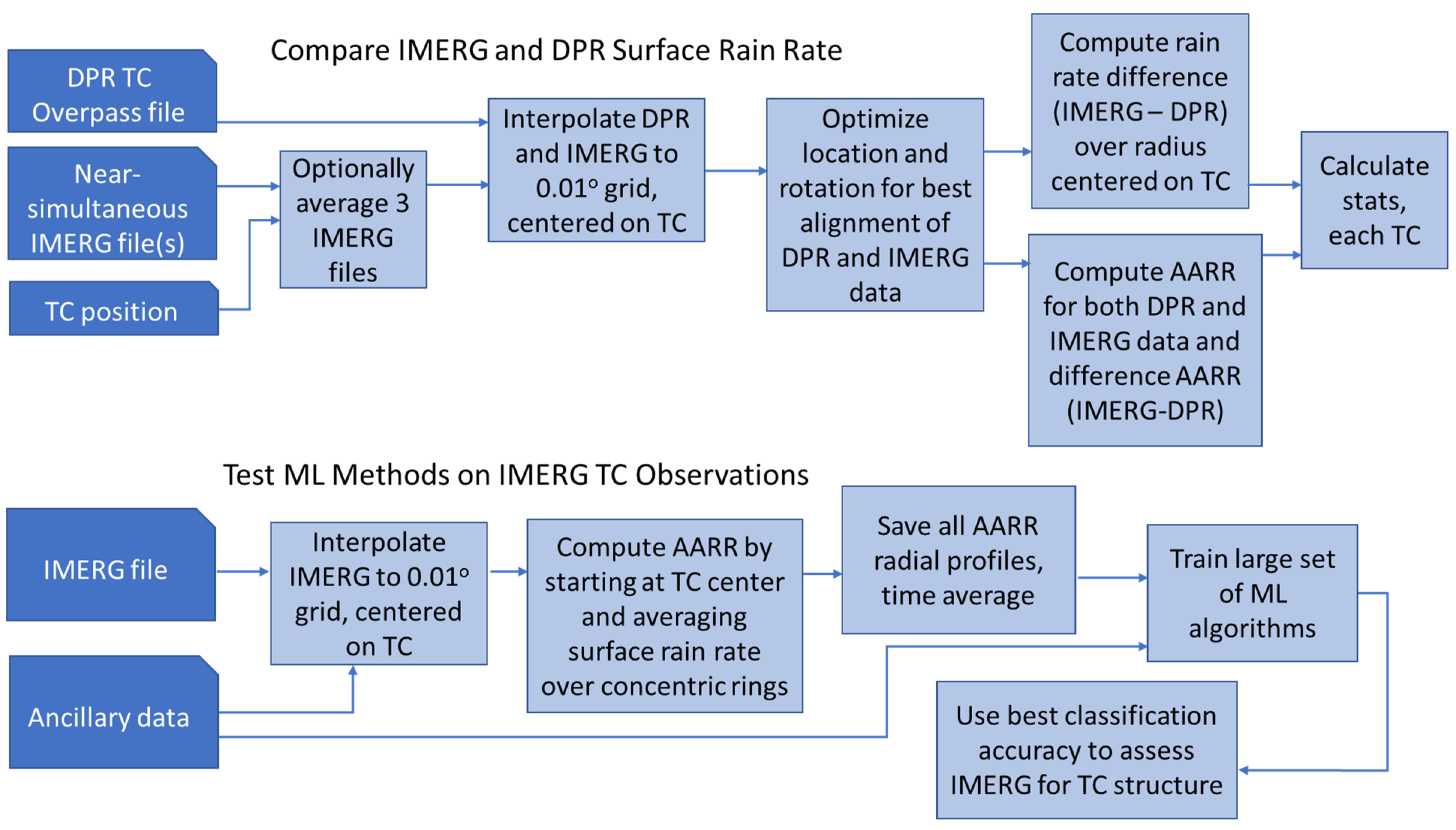
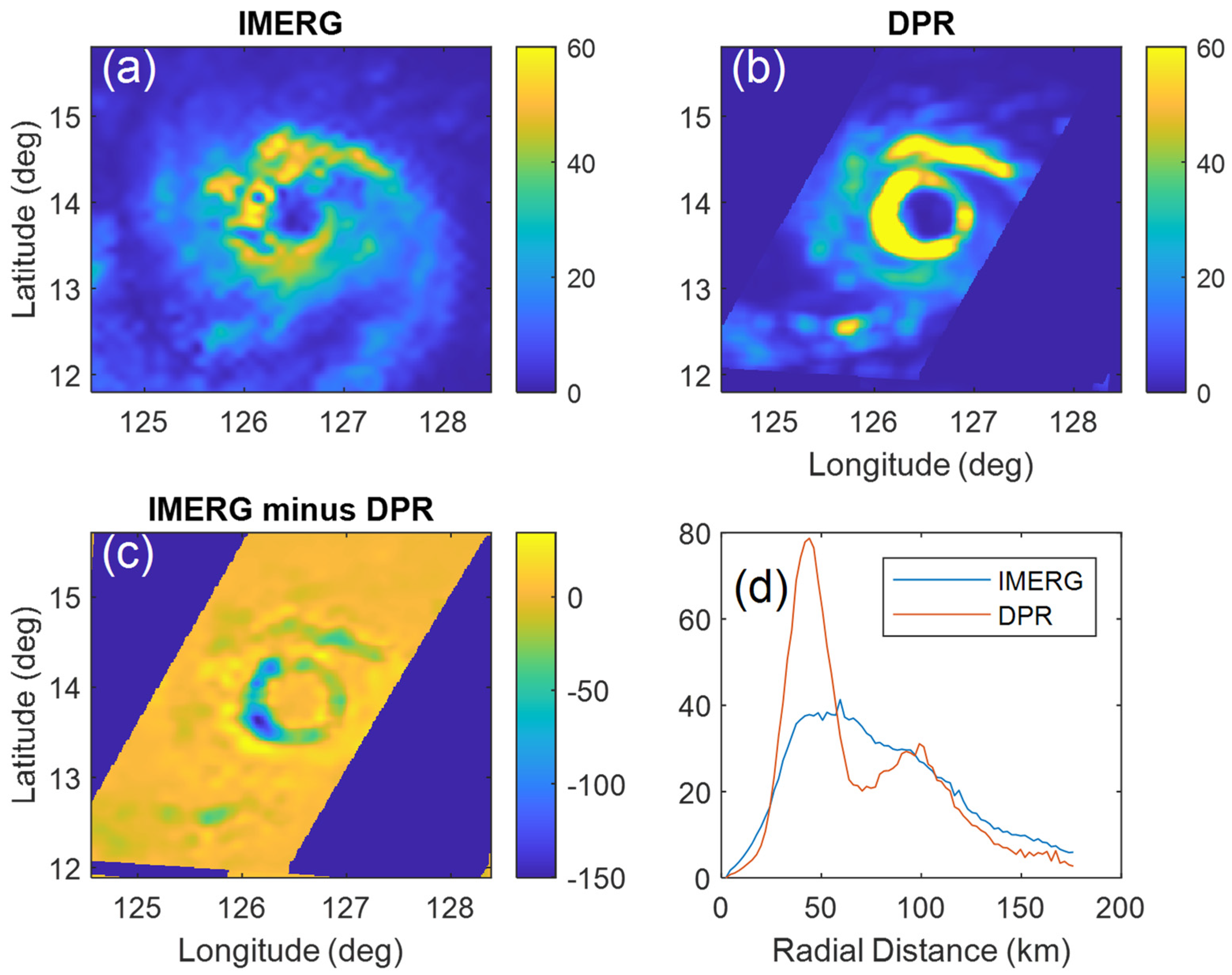
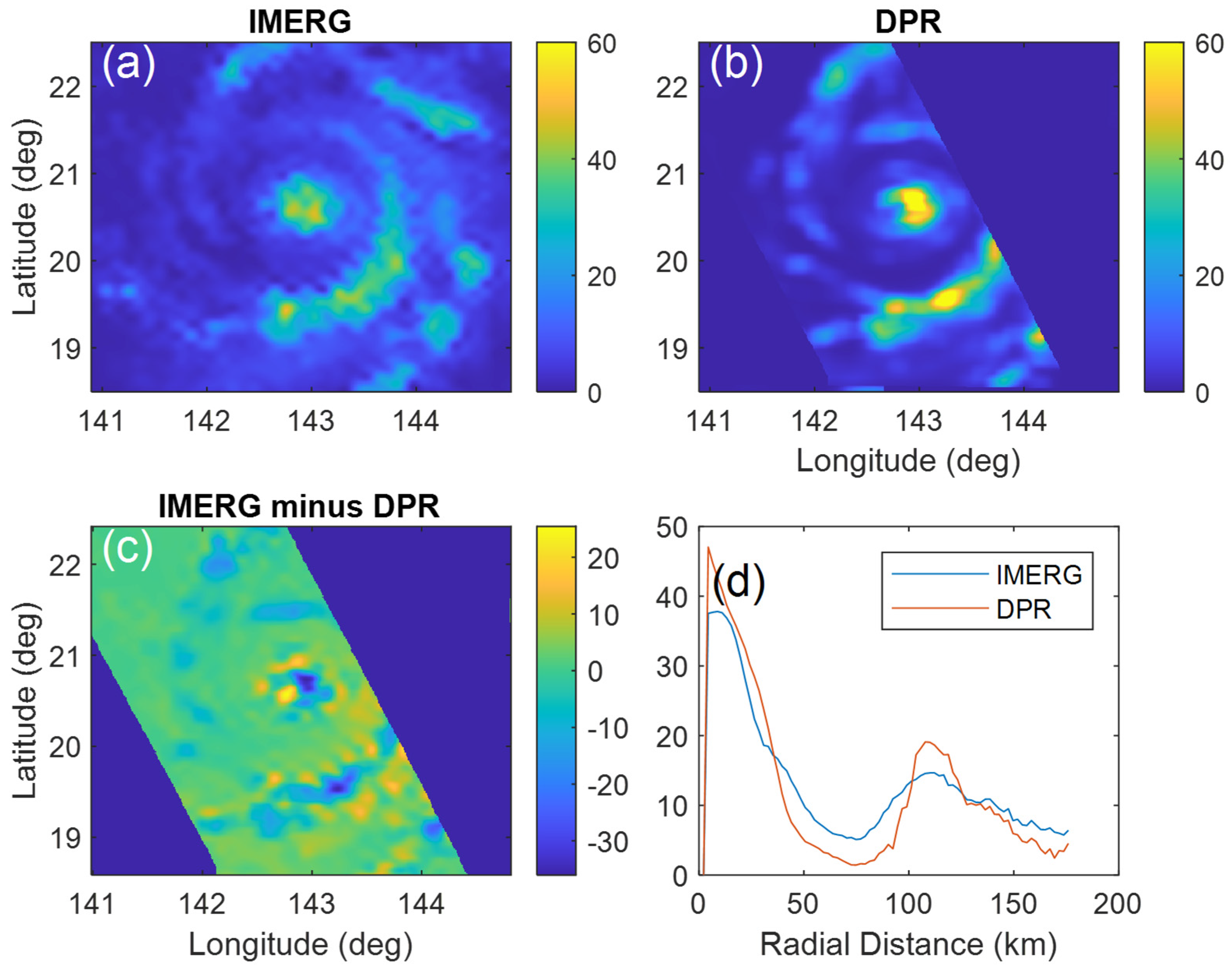
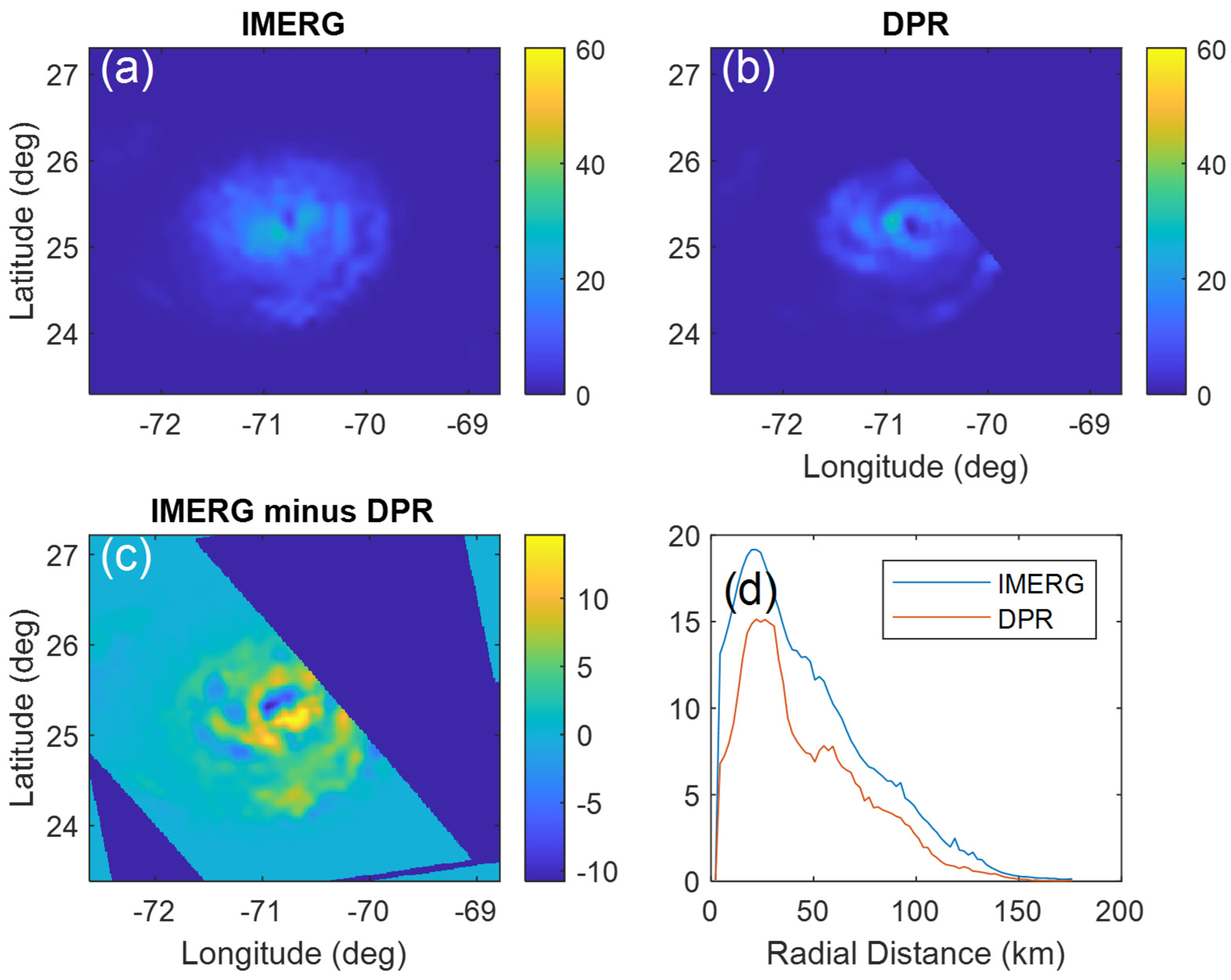


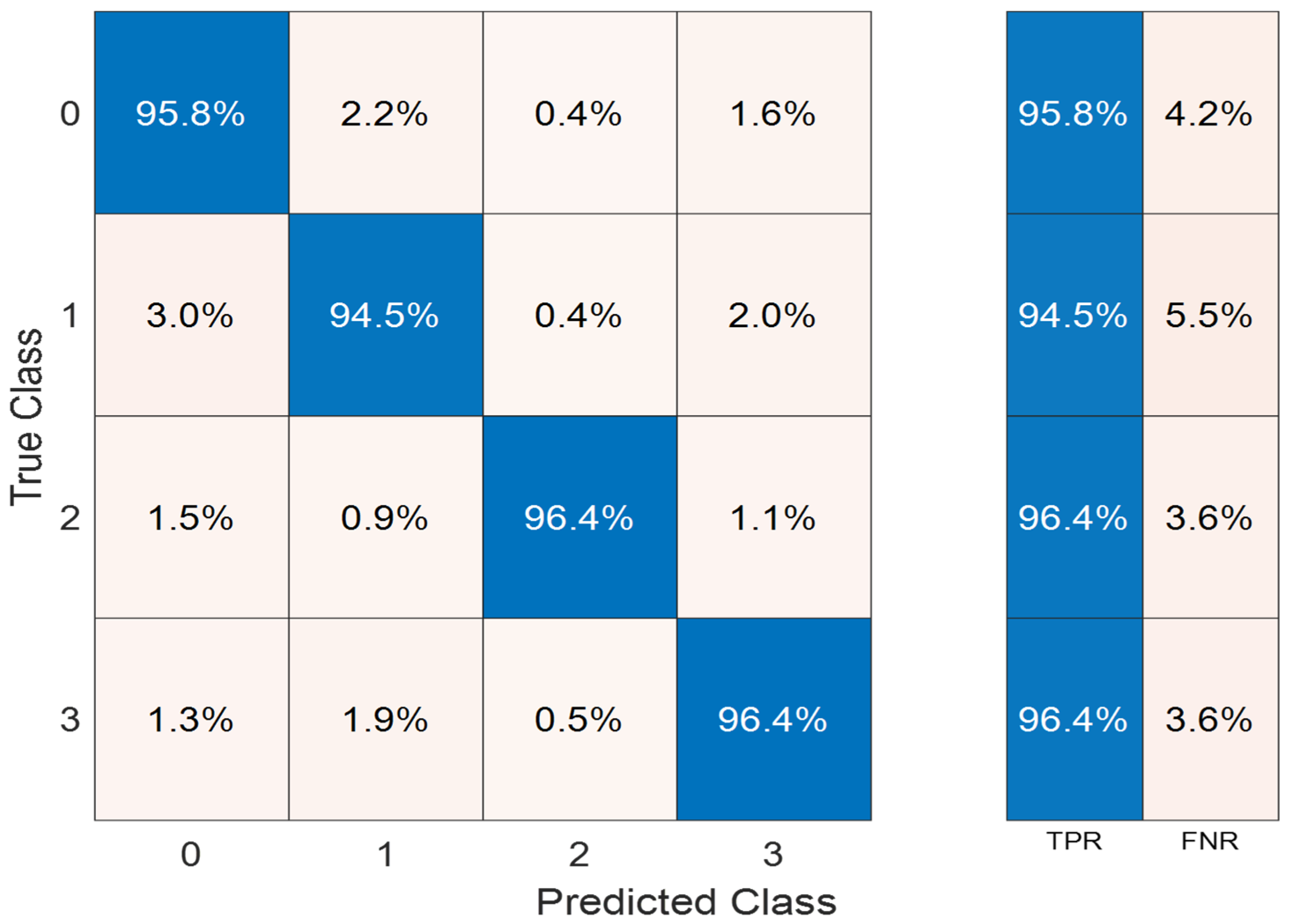
| TC Name | IMERG RR Mean | DPR RR Mean | Std Dev RR Diff | IMERG RR Maximum | DPR RR Maximum | IMERG AARR Maximum | DPR AARR Maximum |
|---|---|---|---|---|---|---|---|
| Surigae | 30.9 | 34.9 | 28.4 | 63.2 | 173.5 | 41.3 | 78.7 |
| Bolaven | 10.8 | 8.6 | 6.2 | 46.5 | 73.0 | 37.8 | 47.0 |
| Dorian | 10.4 | 7.5 | 3.6 | 29.6 | 30.7 | 19.2 | 15.1 |
| Mean | Std Dev | 10th% | 50th% | 90th% | |
|---|---|---|---|---|---|
| 2D RR difference stats: | −1.1 | 15.2 | −5.5 | −1.0 | 3.2 |
| AARR difference stats: | 0.1 | 6.4 | −3.3 | −0.1 | 3.5 |
| AARR diff (r < 70 km): | −1.7 | 9.3 | −14.0 | 0.1 | 6.8 |
| AARR diff (r > 70 km): | 1.2 | 4.2 | −3.2 | 1.3 | 5.6 |
Disclaimer/Publisher’s Note: The statements, opinions and data contained in all publications are solely those of the individual author(s) and contributor(s) and not of MDPI and/or the editor(s). MDPI and/or the editor(s) disclaim responsibility for any injury to people or property resulting from any ideas, methods, instructions or products referred to in the content. |
© 2024 by the California Institute of Technology. Government sponsorship acknowledged. Licensee MDPI, Basel, Switzerland. Submitted for possible open access publication under the terms and conditions of the Creative Commons Attribution (CC BY) license (https://creativecommons.org/licenses/by/4.0/).
Share and Cite
Durden, S.L. Evaluation of IMERG Data over Open Ocean Using Observations of Tropical Cyclones. Remote Sens. 2024, 16, 2028. https://doi.org/10.3390/rs16112028
Durden SL. Evaluation of IMERG Data over Open Ocean Using Observations of Tropical Cyclones. Remote Sensing. 2024; 16(11):2028. https://doi.org/10.3390/rs16112028
Chicago/Turabian StyleDurden, Stephen L. 2024. "Evaluation of IMERG Data over Open Ocean Using Observations of Tropical Cyclones" Remote Sensing 16, no. 11: 2028. https://doi.org/10.3390/rs16112028
APA StyleDurden, S. L. (2024). Evaluation of IMERG Data over Open Ocean Using Observations of Tropical Cyclones. Remote Sensing, 16(11), 2028. https://doi.org/10.3390/rs16112028








